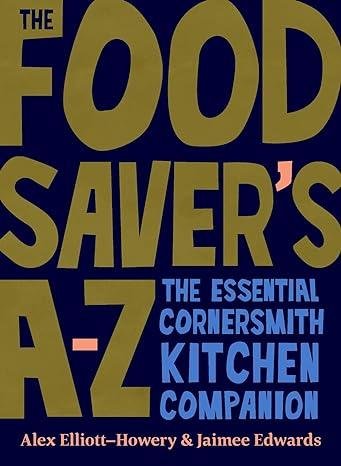The Food Saver's A-Z: A Comprehensive Guide to Sustainable Food Preservation
In a world increasingly aware of the environmental impact of food waste, "The Food Saver's A-Z" by Alex Elliott-Howery and Jaimee Edwards emerges as a beacon of sustainability and practicality. This guide, available in EPUB format, offers readers a thorough exploration of food preservation techniques that not only save money but also contribute to a healthier planet.
Introduction to the Authors
Alex Elliott-Howery and Jaimee Edwards are renowned for their expertise in sustainable food practices. They are the co-founders of Cornersmith, a much-loved café and picklery in Sydney that champions ethical eating and local produce. Their combined knowledge and passion for food waste reduction shine through in "The Food Saver's A-Z," making it an essential resource for anyone looking to make a positive impact through their food choices.
Why Food Preservation Matters
Food preservation is not just about saving leftovers; it's a crucial practice that can significantly reduce household food waste. According to the Food and Agriculture Organization (FAO), one-third of all food produced globally is wasted. This staggering figure underscores the importance of learning how to properly store and preserve food. By adopting these techniques, individuals can help combat food insecurity and environmental degradation.
Overview of "The Food Saver's A-Z"
"The Food Saver's A-Z" is structured alphabetically, making it easy to navigate. Each entry provides detailed instructions on how to preserve a wide variety of foods. From common items like apples and carrots to less familiar ingredients such as kohlrabi and loquats, the book covers an extensive range of produce.
Key Features:
- Alphabetical Organization: The A-Z format allows readers to quickly find preservation methods for specific foods.
- Comprehensive Techniques: The book covers a wide array of preservation methods, including canning, fermenting, pickling, drying, and freezing.
- Practical Tips: Alongside the technical instructions, the authors provide practical tips to make the preservation process easier and more efficient.
- Recipes: To complement the preservation methods, the book includes a selection of recipes that make use of preserved foods, ensuring nothing goes to waste.
In-Depth Look at Preservation Methods
Let's delve into some of the key preservation methods featured in "The Food Saver's A-Z."
Canning
Canning is one of the most reliable ways to preserve food for long periods. The book explains both water bath canning and pressure canning, detailing the equipment needed and the step-by-step process. Safety is paramount in canning, and the authors emphasize the importance of following guidelines to prevent foodborne illnesses.
Fermenting
Fermentation is a natural process that enhances the nutritional value of food. The book covers various fermentation techniques, from making sauerkraut to fermenting dairy products like yogurt and kefir. Fermented foods are rich in probiotics, which are beneficial for gut health.
Pickling
Pickling is a versatile preservation method that adds a tangy flavor to vegetables and fruits. The authors provide recipes for traditional pickles, as well as creative variations like pickled watermelon rind. They also discuss the differences between quick pickling and long-term pickling.
Drying
Drying removes moisture from food, inhibiting the growth of bacteria, yeast, and mold. "The Food Saver's A-Z" includes instructions for air drying, oven drying, and using a dehydrator. This method is particularly useful for preserving herbs, fruits, and vegetables.
Freezing
Freezing is a convenient preservation method that retains the nutritional value of food. The book offers tips on how to properly blanch and freeze vegetables to maintain their texture and flavor. It also covers the best practices for freezing fruits, meats, and prepared meals.
Practical Tips for Successful Preservation
Throughout the book, Elliott-Howery and Edwards share practical tips that make food preservation accessible to everyone. Here are a few examples:
- Labeling: Always label preserved foods with the date and contents to keep track of their shelf life.
- Storage: Use appropriate containers for each preservation method to ensure food stays fresh for as long as possible.
- Batching: Preserve food in small batches to reduce the risk of spoilage and to experiment with different methods and flavors.
- Sanitation: Maintain a clean workspace and sterilize equipment to prevent contamination.
Recipes to Make the Most of Preserved Foods
"The Food Saver's A-Z" doesn't just stop at preservation techniques; it also includes a variety of recipes that incorporate preserved foods. These recipes are designed to minimize waste and maximize flavor. Some highlights include:
- Pickled Vegetable Salad: A vibrant salad that uses a mix of pickled vegetables for a tangy and refreshing dish.
- Fermented Hot Sauce: A spicy condiment made from fermented chili peppers, perfect for adding heat to any meal.
- Dried Fruit Compote: A sweet and nutritious dessert made from dried fruits, ideal for topping yogurt or ice cream.
- Canned Tomato Soup: A comforting soup made from home-canned tomatoes, bringing summer flavors to your table year-round.
"The Food Saver's A-Z" by Alex Elliott-Howery and Jaimee Edwards is more than just a cookbook; it's a manifesto for sustainable living. By embracing the techniques outlined in this book, readers can take meaningful steps toward reducing food waste, saving money, and enjoying a diverse array of preserved foods. Whether you're a seasoned preserver or a beginner, this comprehensive guide is an invaluable resource that will inspire you to make the most of every ingredient. Available in the convenient and versatile EPUB format, it's a must-have for anyone committed to sustainable eating practices.
